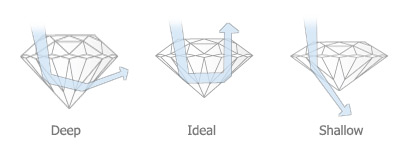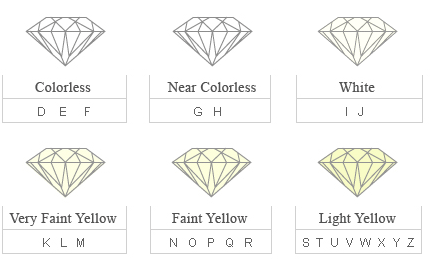Buying a diamond is a new experience for most, and a good starting point is to select a shape which compliments your style. View our chart of shapes here!
Diamond Education
How to Select the Right Diamond
Choose A Shape
Choose a Size
The next step is to choose the size and quality of your diamond. The size chart below shows carat weight and approximate measurements of corresponding weight of the diamond when seen face up. View our chart of diamond sizes here!
Learn about Quality: The 4C’s
The 4 C’s stand for Cut, Color, Clarity, and Carat weight. There are a wide variety of diamond sizes and qualities available within any given budget. With the right information, you’ll be able to figure out which qualities are most important to you.
Cut:

The cut of a diamond determines its brilliance and sparkle. Cut is considered to be the most important of all of the diamond characteristics as it is what determines the overall beauty and ‘life’ of a diamond. Diamonds with perfect clarity or color but which are badly cut can appear dull and lifeless, but the best cut diamonds have proportions that are consistently known for maximizing brilliance and overall beauty.
Color:

The color of a diamond results from natural elements of nitrogen that existed when the diamond formed under the Earth. Most diamonds naturally show a degree of yellow, brown, green or grey. The most common color and hue is yellow. The amount of yellow hue is graded according to a scale which ranks the lack of color with the highest letter grade which ranges from D (colorless) to Z (heavy yellow). Diamonds whose color is beyond Z are denoted as “fancy color” diamonds and are graded using their own scale and terminology. The less color that appears in a diamond, the more rare it is, and therefore the higher the value.
Clarity:

The clarity of a diamond is measured by the number of internal characteristics called imperfections and external characteristics called blemishes. The number, size, nature, and position of these characteristics all affect the final clarity grade of a diamond. Although no diamond is perfectly pure, diamonds with no or few inclusions are very rare and much higher in value.
The diamond grading scale is made of 6 categories, some of which are divided, for a total of 11 categories. All diamond clarity grading is determined using a 10X magnification.
- Flawless (FL)
No inclusions and no blemishes visible under 10x magnification - Internally Flawless (IF)
No inclusions visible under 10x magnification - Very, Very Slightly Included (VVS1 and VVS2)
Inclusions so slight they are difficult for a skilled grader to see under 10x magnification - Very Slightly Included (VS1 and VS2)
Inclusions are observed with effort under 10x magnification, but can be characterized as minor - Slightly Included (SI1 and SI2)
Inclusions are noticeable under 10x magnification - Included (I1, I2, and I3)
Inclusions are obvious under 10x magnification which may affect transparency and brilliance
Carat:

The term “carat” refers to the weight of a diamond. Just like there are 100 pennies in a dollar, the same calculation holds true with the weight of a diamond. 100 points equals 1 carat. Hence, 50 points is equal to 1/2 a carat and so on. The value of a diamond rises exponentially because larger diamonds are rarer and more desirable. Click here to view the full sizing chart!
Other Characteristics
Fluorescence:
Diamond fluorescence is the effect that ultraviolet (UV) light has on a diamond. When you stand under a blue light or ultraviolet light, you can see the white part of your cloths get brighter or your teeth appear to glow. This is the same effect the diamond has under the UV rays. Fluorescence in a diamond is the visible light that emits when it is exposed to the UV rays.
The most visible color in over 95% of diamonds with fluorescence is blue. Being that blue is the complementary color to yellow, the most common tinted color in diamonds, blue florescence can sometimes make slightly tinted yellow diamonds look white. For this reason, diamonds with color from I -L with Medium to Very Strong florescence can trade at a premium if it causes the diamond to appear whiter.
When considering a diamond between D-H color, Strong Blue and Very Strong Blue florescence should be carefully evaluated to not have a milky or oily effect which will significantly reduce the brilliance and fire of the diamond.
Polish:
Polish refers to how smooth each facet of a diamond is, as determined by a gemologist. During the manufacturing process of a diamond, the level of polish is determined by many factors. The most influential factor is weight. The better the polish is on a diamond, the more weight is lost during the process. To the untrained eye, diamonds with Excellent, Very Good and Good polish will not affect the appearance of the diamond.
Symmetry:
Symmetry refers to how precisely the facets in a diamond line up with one another. Being that this characteristic is the “engineering” part of the diamond; its importance has more of a perceived impact than the actual appearance to the untrained eye. For this reason, diamonds possessing Excellent symmetry and Excellent polish can trade 10-15% higher than diamonds with Very good or Good.
Since diamonds with symmetry of Excellent, Very Good or Good exists in diamonds of exceptional appearance, it should not be the primary reason to choose or reject a diamond.
Diamonds with Fair or Poor symmetry should be avoided due to visible weakness to the untrained eye
Culet:
The culet in a diamond is where the pavilion (bottom portion of the stone) comes to a point. If the cutlet is left open, you will be able to see from the top of the diamond what looks like a hole or opening at the bottom of the stone.
This is a characteristic the most in the trade try to avoid. The culet size is defined on the certificate and you should look for None, Very Small, Small or Medium to avoid this visible opening.
Diamond Certification
House Of Brilliance diamonds are certified by the leading laboratories in the world including GIA, AGS, IGI, EGL USA, and HRD. These independent labs provide a professional opinion that substantiates the price of a diamond. Diamond dealers very often conduct business sight unseen through these diamond grading reports. If you are interested in a House of Brilliance diamond, you can view its certificate on our site before purchase. If you cannot view the cert on our site, simply contact one of our fine jewelry specialists at [email protected] or 800-755-6627.
Need help finding the perfect diamond?
We are happy to help!



